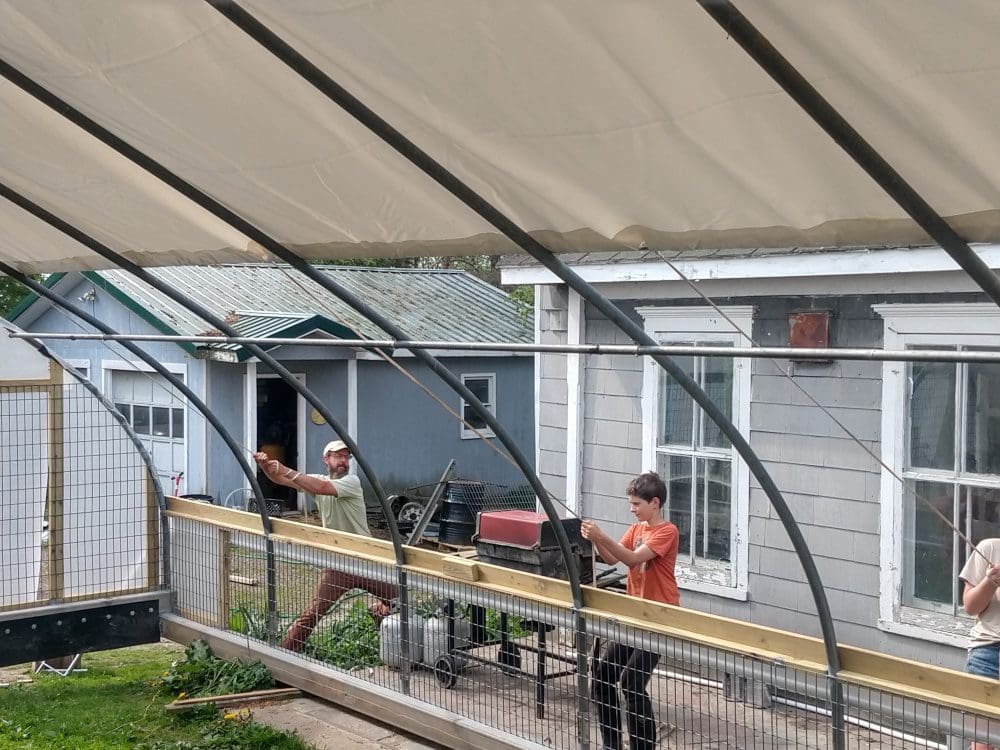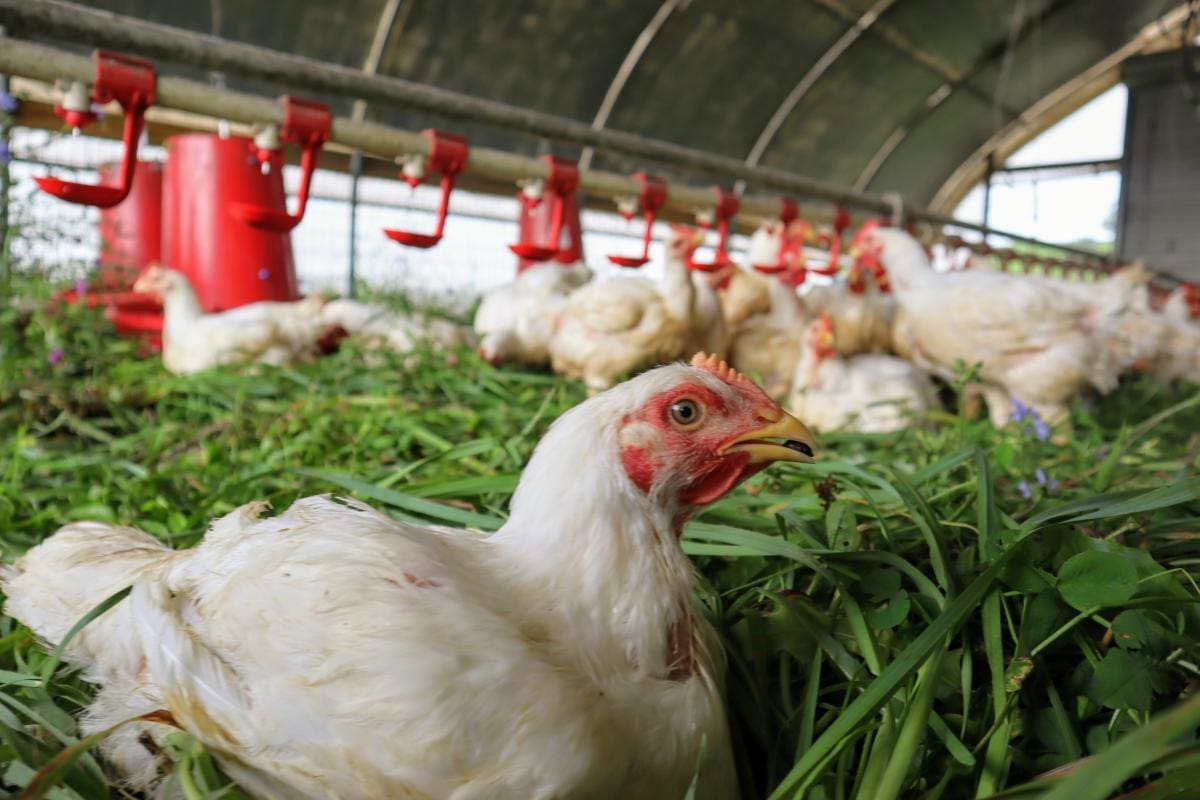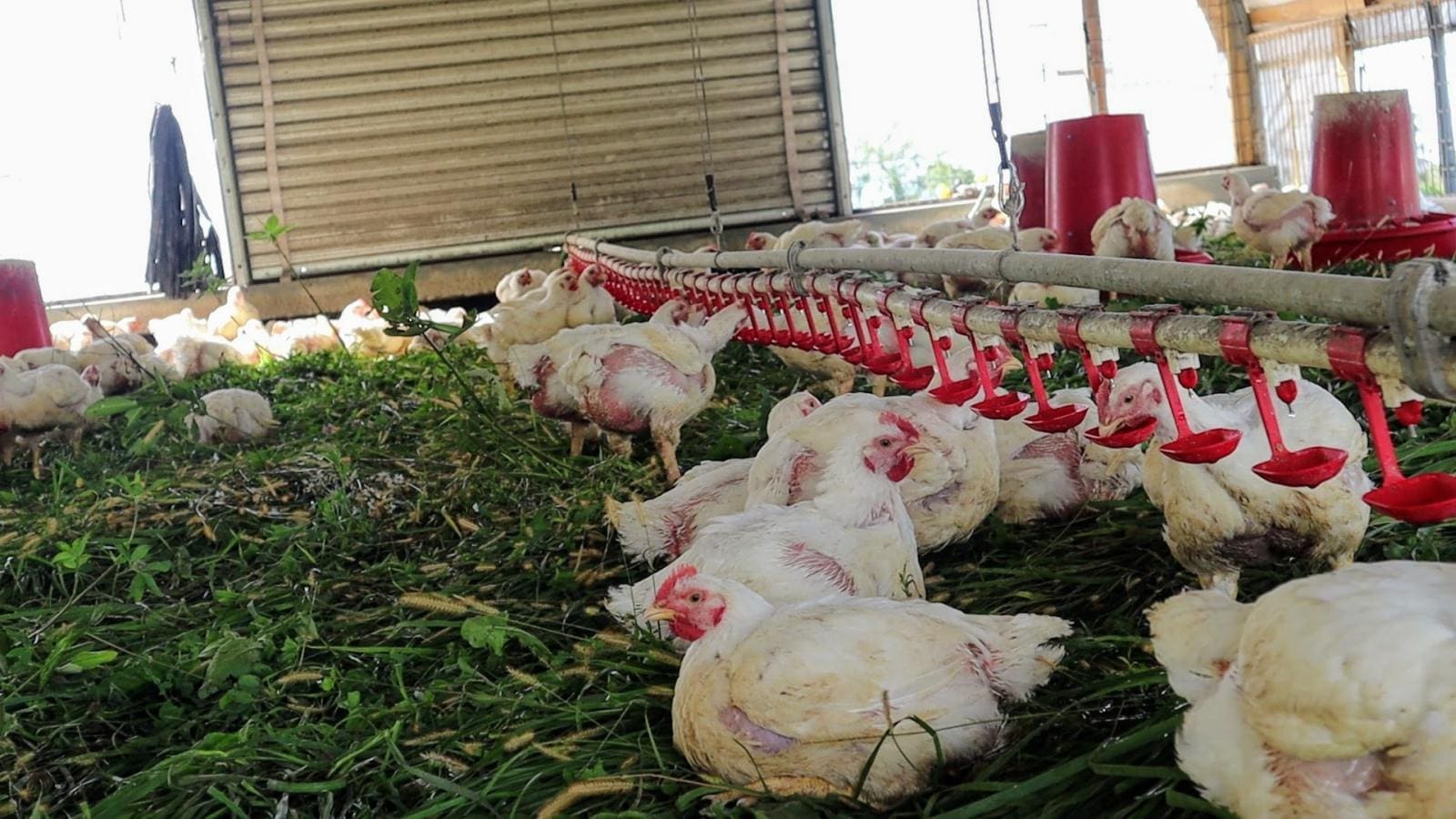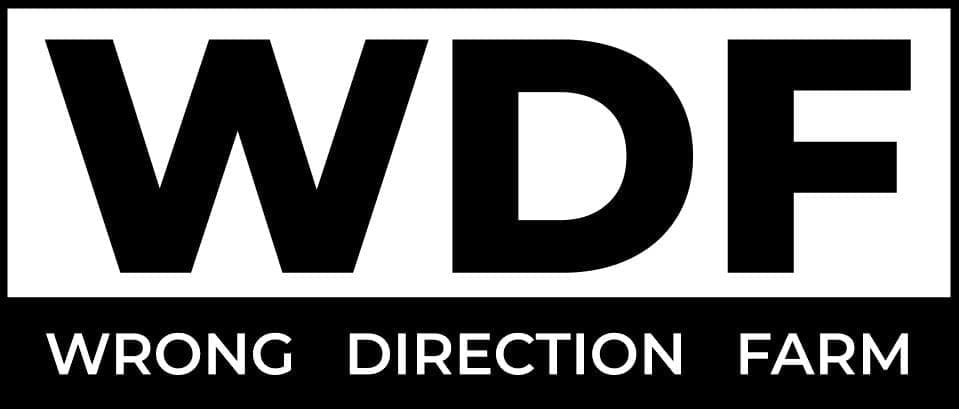I took a few minutes with the chickens out in the pasture to highlight some of the design features and considerations we incorporated into our custom made shelters.
Hi, this is Dave, your farmer from Wrong Direction Farm. Today I’d like to give you a quick tour of our chicken shelters.
We use these shelters on pastures so our chickens always have access to fresh grass. The basic thing we’re trying to accomplish with our chicken shelters is to give the chickens grass underfoot. We need them to be able to move to fresh grass so the whole structure needs to be mobile as we tow it around the pastures on a daily basis.
So we built these shelters – actually we’ve built five of these shelters – that we have here. Over the years we’ve built many types of chicken coops and shelters from very small ones up to the current size we have now.
It’s important to note that chickens are originally an Asian jungle bird and so their ideal environment is not to be out in the direct sunlight out on a totally exposed pasture. They do like to shelter under things and that’s why we’ve given them this covering. It also protects them from predators. You know owls are actually the biggest predator threat we have on our farm. We have hawks and we have eagles and they all will attack a chicken given the chance but owls are kind of the super avian predator around here.
Although they need to be protected from predators we do want them to experience as much of the outdoor goodness as they can get. So we’ve got ventilated sides you can see on here. All the sides of the coops are ventilated. There are actually flaps that we can roll down if there’s a big storm coming in, but almost all the time we just leave them wide open. Maybe in the fall when the weather gets a little cooler we sometimes have to roll them down.
But chickens are out in the sun and you can see (interjection – there’s some little squabble) there you can see there’s some other chickens here resting in the shade. So that’s a pretty good balance.
So let’s take a look at the grain feeders that the chickens use. These are their feeders. These are 50 pound hanging feeders and they are tied through this cable up to a bunch of pulleys on the ceiling that all run down to the other side of the building to a winch mounted up near the hoop.
We’ve also got waterers down here. And these are just little nipples that hang down and the chickens can drink from them. It prevents them from making too much of a mess on the ground. If any water drips down you can see the chicken can catch it out of these cups
They have to tilt their head up to swallow so you see after every drink, head goes up, water goes down.
So our shelters are framed on these 6×6 beams. These are actually old New York State Thruway guard rail box beams. We found a contractor that removes them from Thruway sites after there have been crashes and snow plow damage and things like that. And he saves the better sections and sells them. They’re still, they’re still relatively expensive but they’re cheaper than buying new steel and they’re they’re nicely galvanized. So these come in 36 foot lengths and that kind of sets the length for our chicken shelters.
The frames for the shelter are old greenhouse frames that we’ve bought either on Craigslist or by knocking on doors at abandoned old greenhouses and offering to buy the greenhouse frames from the land owner.
So those are our chicken shelters. Let me know if you have any questions. I’d be interested in hearing from you. Thanks!
At Wrong Direction Farm we’ve always been driven by both personal preference and economic necessity to be do-it-yourselfers. About six years ago we realized we needed to upgrade our chicken shelters, so we started down a path of designing and building durable, portable pasture coops. While I’m certain that we haven’t arrived at a perfect design, our current setup really suits the chickens well and it allows us to go about our daily chores in an efficient manner.
Galvanized steel box beams frame the shelter bases. These are salvaged steel from New York Thruway projects. We found a contractor that replaces miles and miles of these guardrails, and they save the best ones for resale for use in parking lots and places where older guardrails can have a second life. Using these recycled resources helps with farm infrastructure. We now have several chicken feeding trailers and a corral built with various types of recycled guardrail.

The box beams are heavy enough. Weighing in at one ton they ballast the shelters in high winds. They also provide a smooth, strong base suitable for dragging across irregularities in the terrain. For more on how we move our pasture shelters for chickens, see this post. To prevent the box beams from digging into the dirt, we weld short “ski tips” on the ends, little sections where the beam slopes up at a 45 degree angle.
For ribbing, we use old greenhouse frames. They take some effort to find, but we have been able to purchase unused greenhouses from Craigslist ads and also from knocking on doors. Last year we disassembled a very nice frame that yielded enough hoops to make three chicken shelters. We’ve looked at buying brand new frames, but some of these older greenhouses use much thicker steel than any of the kits we’ve been able to find. Given the choice, I’ll take strong over shiny!

Billboard tarp material works well as a covering. Originally we were able to buy used billboards. But lately we’ve had a harder time sourcing them in the right sizes, so we pay a billboard company to send us custom-sized unprinted billboards. One important lesson learned along the way relates to the color of tarps. Having white on the outside and some color on the inside is ideal. Dark exterior colors absorb too much heat, but pure white tarps transmit and reflect too much sun inside the shelters. We started painting all our new white-on-white tarps with a layer of grey paint on the inside. This creates the perfect level of shade.

So the chickens can enjoy all the benefits of fresh air and sunshine as their shelters move across the pasture, we installed wire mesh along all side of the shelter. This permits a cross breeze. It also gives the chickens sunny spots when they want them, and plenty of shady spots when those are preferable. If the weather becomes particularly challenging (this is mainly when we have a combination of wet and cold) we roll down flaps over the wire mesh. But for most of the season we’ve got the sides all wide open.
Our chickens eat pasture plants and bugs, but we also give them certified organic grain. We use hanging feeders. All the feeders interconnect by a series of pulleys and cables tied back to a battery powered winch. We maintain the charge with a simple solar cell positioned above the roof. The winch raises the feeders every time we move the chickens. This makes it easier to herd all the birds when we’re moving them. It also allows us to quickly adjust the feeder heights as the chickens grow.

The last major feature to list is the watering system. All our pasture shelters have nipple drinkers for the chickens. These feature a series of needle-like nipples all down the length of a water pipe. As the chickens peck at a metal pin, a drop of water releases. These waterers allow the chickens to remain hydrated while preventing the messes associated with open-trough waterers.
Each of these shelters represents a significant investment. Between the guardrails, greenhouse hoops, doors, tarps, feeders, waterers, and all the supporting equipment and hardware, we spend about $5,000 on each of these shelters. In order to pay for themselves, we need them to perform well for chickens throughout the grazing season, year after year. Thus far, they haven’t let us down.
But am I “settled” on this particular housing design for pasture raised chickens? Not hardly. I’ve got a bunch of ideas cooking. Each new build gives me a chance to think about improving the next one. If I can change one thing, it will probably be the feeders. At present we have a feeder system that works if I modify the parts the manufacturer supplies, but I think with some creative fabrication I can come up with something much better. The possibilities for tinkering and improvement keeps farming both challenging and enjoyable.
